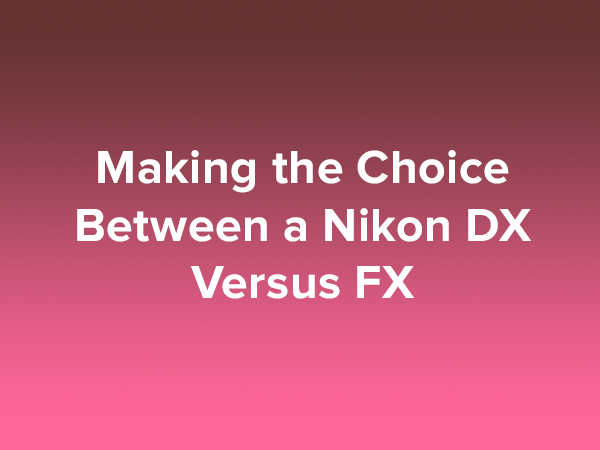Making the Choice Between a Nikon DX Versus FX
Making the Choice Between a Nikon DX Versus FX
When you are aiming to improve the quality of your images, you may run into a common question asked by photographers at one point or another: Should I shoot with a Nikon DX or FX? If you’re in the process of learning more about your Nikon, you may not yet know the difference between these two format sensors or what makes one preferable to the other.

Before you can make decisions about DX and FX cameras, it’s first important to understand how camera sensor formats work. Similar to the human eye, sensor formats gather, control and manipulate light, which affects the quality and clarity of the picture. Notice how images taken with disposable camera come out grainier and less sophisticated than a picture taken with a professional-grade camera? This is because the image sensor in the latter is larger and more sophisticated, the sensitivity of which allows it to pick up more color and sharpness.
With regards to the DX and FX image sensors, Nikon’s first image sensor was the DX. It is widely used in entry-level, semi-professional and professional Nikon cameras. The initial mega-pixel size began at 2.66, but was increased steadily over the years through upgrades. The D7000, the newest Nikon DX camera, produces 16 mega-pixel images. The D7000 replacement, expected to be announced soon, will probably produce 24 mega-pixel images, but this has not yet been announced.
Updates and improvements in sensor technology have made the smaller DX sensor more preferable in some scenarios. The DX sensor makes images appear magnified when compared to the same scene captured with an FX image sensor. Because the DX sensor is smaller than the FX sensor, it captures a smaller center area of the subject being photographed and discards everything else around it. This is called the “crop factor.”
The FX sensor is equivalent to the old standard 35mm film, 36x24mm in size. The bigger sensor image allowed Nikon to also increase the megapixels without sacrificing the quality of the images – a scenario that was beginning to occur when it added more megapixels to the smaller-sized DX format. The pixels are actually a bit larger in an FX camera than they are in a DX camera thereby creating less noise at higher ISOs. In addition, the fact that the FX sensors are the same size as the film eliminates the cropping effect of the images.
The most recent FX camera that Nikon has introduced is the D800. This camera captures images with 32 megapixels. The D600, also an FX camera introduced around the same time captures images with 24 megapixels. The question of whether 32 megapixels is too much due it the size and increased noise at high ISOs (above 3200) is the subject for another article.
As to the choice between an FX and a DX camera, there are advantages and drawbacks to both. While FX sensors are more expensive creating higher cost for cameras and lenses, they provide better resolution and higher sensitivity. However, the DX sensors create the opportunity for less expensive and more affordable lenses for DX cameras. These lenses can sometimes provide better reach and sharper corners than their FX lens equivalents.
It is always important to take your photography needs and preferences into consideration before buying a camera. If you are not sure which camera to buy, it is better to error on the side of the DX camera. Perhaps the compromise to make is to buy FX lenses when you are ready to add lenses. These will work well on DX cameras and if you decide that an FX camera suits your needs better, you will already have lenses to use on it.
Always remember that technology changes rapidly and you will eventually buy a new camera body. However, Nikon lenses last forever. You will use the lenses you buy today on any Nikon body you own in the future or any Nikon body you may have owned for the last 50 years.
